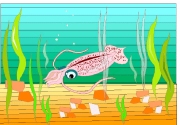
Worksheets and No Prep Teaching Resources
Reading Comprehension Worksheets
Oceans

Oceans
 Worksheets and No Prep Teaching Resources Reading Comprehension Worksheets Oceans |
 Oceans |
| edHelper's suggested reading level: | grades 8 to 9 | |
| Flesch-Kincaid grade level: | 7.46 |
|
The Ocean Floor
By Sharon Fabian |

|
 1 In ancient times, sailors had to be very brave to sail out across the ocean in their wooden sailing ships. They knew that the ocean was dangerous. In fact, anyone who had been a sailor for a while probably knew of someone who had sailed out, never to return. What these sailors didn't know was what caused the dangers in the ocean. They didn't know what was really out there. So sailors pictured the ocean as a bottomless pit with huge, scary sea creatures living in the deep water. Adventure stories about sailors told of ships that were sunk or wrecked when a sea monster suddenly rose up through the water.
1 In ancient times, sailors had to be very brave to sail out across the ocean in their wooden sailing ships. They knew that the ocean was dangerous. In fact, anyone who had been a sailor for a while probably knew of someone who had sailed out, never to return. What these sailors didn't know was what caused the dangers in the ocean. They didn't know what was really out there. So sailors pictured the ocean as a bottomless pit with huge, scary sea creatures living in the deep water. Adventure stories about sailors told of ships that were sunk or wrecked when a sea monster suddenly rose up through the water. |
Create Weekly Reading Books
Prepare for an entire week at once! |
| Leave your feedback on The Ocean Floor (use this link if you found an error in the story) |
 |
Oceans
|
 |
High School Reading Comprehensions and High School Reading Lessons
|
|
|